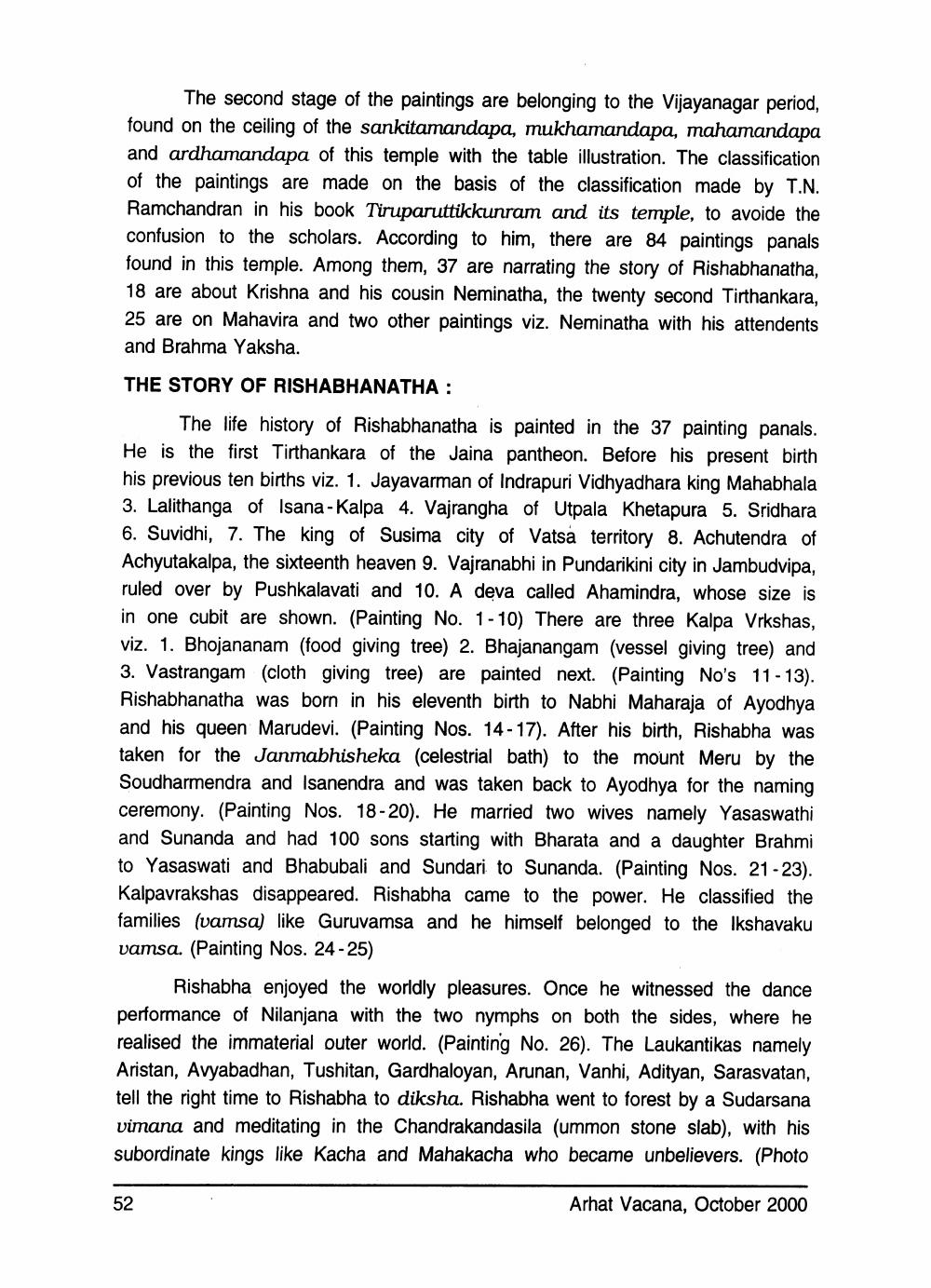________________
The second stage of the paintings are belonging to the Vijayanagar period, found on the ceiling of the sankitamandapa, mukhamandapa, mahamandapa and ardhamandapa of this temple with the table illustration. The classification of the paintings are made on the basis of the classification made by T.N. Ramchandran in his book Tiruparuttikkunram and its temple, to avoide the confusion to the scholars. According to him, there are 84 paintings panals found in this temple. Among them, 37 are narrating the story of Rishabhanatha, 18 are about Krishna and his cousin Neminatha, the twenty second Tirthankara, 25 are on Mahavira and two other paintings viz. Neminatha with his attendents and Brahma Yaksha.
THE STORY OF RISHABHANATHA :
The life history of Rishabhanatha is painted in the 37 painting panals. He is the first Tirthankara of the Jaina pantheon. Before his present birth his previous ten births viz. 1. Jayavarman of Indrapuri Vidhyadhara king Mahabhala 3. Lalithanga of Isana-Kalpa 4. Vajrangha of Utpala Khetapura 5. Sridhara 6. Suvidhi, 7. The king of Susima city of Vatsa territory 8. Achutendra of Achyutakalpa, the sixteenth heaven 9. Vajranabhi in Pundarikini city in Jambudvipa, ruled over by Pushkalavati and 10. A deva called Ahamindra, whose size is in one cubit are shown. (Painting No. 1-10) There are three Kalpa Vrkshas, viz. 1. Bhojananam (food giving tree) 2. Bhajanangam (vessel giving tree) and 3. Vastrangam (cloth giving tree) are painted next. (Painting No's 11-13). Rishabhanatha was born in his eleventh birth to Nabhi Maharaja of Ayodhya and his queen Marudevi. (Painting Nos. 14-17). After his birth, Rishabha was taken for the Janmabhisheka (celestrial bath) to the mount Meru by the Soudharmendra and Isanendra and was taken back to Ayodhya for the naming ceremony. (Painting Nos. 18-20). He married two wives namely Yasaswathi and Sunanda and had 100 sons starting with Bharata and a daughter Brahmi to Yasaswati and Bhabubali and Sundari to Sunanda. (Painting Nos. 21-23). Kalpavrakshas disappeared. Rishabha came to the power. He classified the families (varsa) like Guruvamsa and he himself belonged to the Ikshavaku vamsa. (Painting Nos. 24-25)
Rishabha enjoyed the worldly pleasures. Once he witnessed the dance performance of Nilanjana with the two nymphs on both the sides, where he realised the immaterial outer world. (Painting No. 26). The Laukantikas namely Aristan, Avyabadhan, Tushitan, Gardhaloyan, Arunan, Vanhi, Adityan, Sarasvatan, tell the right time to Rishabha to diksha. Rishabha went to forest by a Sudarsana vimana and meditating in the Chandrakandasila (ummon stone slab), with his subordinate kings like Kacha and Mahakacha who became unbelievers. (Photo
Arhat Vacana, October 2000
52




